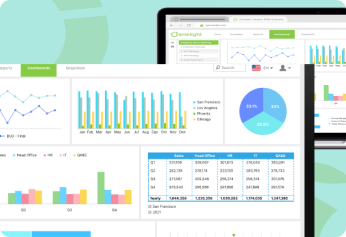When finance teams struggle with manual spreadsheet work and fragmented data sources, understanding fundamental analysis techniques becomes even more critical. Vertical analysis stands as one of the most practical tools for quickly assessing financial performance, helping finance professionals cut through complexity to identify what matters most in their financial statements.
This technique transforms raw financial data into meaningful percentages, making it easier to spot trends, compare performance across periods, and communicate insights to stakeholders who may not have deep financial expertise.
What is Vertical Analysis?
Vertical analysis is a financial statement analysis method where each line item is expressed as a percentage of a base figure within the same financial statement. Think of it as creating a financial "recipe" – instead of looking at raw dollar amounts, you see what percentage each ingredient contributes to the whole.
For income statements, every line item becomes a percentage of total revenue. For balance sheets, each item is expressed as a percentage of total assets. This approach immediately reveals the relative importance of different components and makes comparisons more meaningful.
Unlike horizontal analysis, which tracks changes over time, vertical analysis provides a snapshot of financial structure at a specific point. It answers questions like: "What percentage of our revenue goes to cost of goods sold?" or "How much of our total assets are tied up in inventory?"
How Vertical Analysis Works
The process involves selecting an appropriate base figure and calculating each line item as a percentage of that base. The base figure always equals 100%, and all other items are calculated relative to it.
The formula is straightforward: Percentage = (Line Item Amount ÷ Base Amount) × 100
For income statements, the base is typically total revenue or net sales. For balance sheets, total assets serve as the base for all items. This standardization makes it possible to compare companies of different sizes or the same company across different periods.
Performing Vertical Analysis
Here's how to conduct vertical analysis systematically:
Step 1: Choose the appropriate financial statement (income statement, balance sheet, or cash flow statement).
Step 2: Identify the base figure:
- Income Statement: Total Revenue/Net Sales
- Balance Sheet: Total Assets
- Cash Flow Statement: Net Cash Flow
Step 3: Calculate percentages for each line item using the formula above.
Step 4: Verify that your calculations are accurate by ensuring related items add up correctly (e.g., all asset categories should total 100%).
Step 5: Create a formatted presentation showing both dollar amounts and percentages side by side.
Step 6: Analyze the results by looking for significant percentages, unusual patterns, or items that seem disproportionate.
Examples of Vertical Analysis
Income Statement Example
Let's examine a simplified income statement for ABC Manufacturing:
|
Line Item |
Amount ($000) |
Percentage of Revenue |
|
Revenue |
$1,000 |
100.0% |
|
Cost of Goods Sold |
$600 |
60.0% |
|
Gross Profit |
$400 |
40.0% |
|
Operating Expenses |
$250 |
25.0% |
|
Operating Income |
$150 |
15.0% |
|
Interest Expense |
$20 |
2.0% |
|
Net Income |
$130 |
13.0% |
This analysis immediately reveals that ABC Manufacturing maintains a 40% gross margin, with operating expenses consuming 25% of revenue. The 13% net margin provides a clear benchmark for performance evaluation.
Balance Sheet Example
Here's a balance sheet vertical analysis for the same company:
|
Line Item |
Amount ($000) |
Percentage of Total Assets |
|
Assets |
||
|
Cash |
$50 |
5.0% |
|
Accounts Receivable |
$150 |
15.0% |
|
Inventory |
$200 |
20.0% |
|
Property, Plant & Equipment |
$600 |
60.0% |
|
Total Assets |
$1,000 |
100.0% |
|
Liabilities & Equity |
||
|
Accounts Payable |
$100 |
10.0% |
|
Long-term Debt |
$300 |
30.0% |
|
Total Equity |
$600 |
60.0% |
|
Total Liab. & Equity |
$1,000 |
100.0% |
This shows ABC Manufacturing is asset-heavy (60% in PP&E), maintains moderate debt levels (30%), and has a strong equity position (60%).
Vertical vs. Horizontal Analysis
Understanding when to use each analysis method helps maximize their value:
|
Aspect |
Vertical Analysis |
Horizontal Analysis |
|
Purpose |
Shows financial structure at a point in time |
Tracks changes over multiple periods |
|
Base |
Single period base figure (100%) |
Base year or period for comparison |
|
Best for |
Company size comparisons, structural analysis |
Trend identification, growth analysis |
|
Output |
Percentages of total |
Percentage changes over time |
|
Questions Answered |
"What's our cost structure?" |
"How are we trending?" |
Many finance teams use both methods together. Vertical analysis reveals what's important right now, while horizontal analysis shows how those important items are changing over time.
Importance and Benefits of Vertical Analysis
Vertical analysis delivers several key advantages that make it indispensable for financial planning and analysis:
- Standardization Across Comparisons: Companies of vastly different sizes become comparable. A $10 million company and a $100 million company can be analyzed using the same percentage framework.
- Quick Pattern Recognition: Unusual cost structures or asset allocations become immediately apparent. If administrative expenses suddenly represent 40% of revenue when industry norms are 15%, that's a clear red flag.
- Simplified Communication: Percentages are easier for non-financial stakeholders to understand than raw dollar figures. Telling a board that "marketing represents 12% of revenue" is more meaningful than "$2.4 million in marketing spend."
- Benchmarking Capabilities: Industry averages and competitor comparisons become possible when everything is expressed in percentage terms.
- Budget Planning Support: Understanding current financial structure helps in setting realistic targets for future periods.
Limitations of Vertical Analysis
Despite its usefulness, vertical analysis has important constraints that users must understand:
- Snapshot Limitation: Vertical analysis only shows one moment in time. A company might look healthy in December but have struggled throughout the year.
- Missing Context: Percentages don't reveal absolute performance. A company might have excellent cost control (low expense percentages) but declining revenue.
- Base Figure Distortion: If the base figure is unusual – perhaps due to one-time revenue or write-downs – all percentages become misleading.
- Industry Variations: What's normal varies dramatically between industries. A 60% cost of goods sold might be excellent for retail but terrible for software companies.
- Seasonal Effects: Companies with seasonal businesses may show very different vertical analysis results depending on the period selected.
- No Trend Information: Unlike horizontal analysis, vertical analysis doesn't show whether percentages are improving or deteriorating over time.
Streamlining Financial Analysis with Modern Tools
While vertical analysis remains a cornerstone of financial analysis, the manual process of calculating percentages and creating formatted reports can be time-consuming and error-prone. Finance teams spending hours in spreadsheets often struggle to perform this analysis consistently across periods or to integrate it with other planning activities.
Modern FP&A platforms can automate these calculations, ensuring accuracy while freeing up time for actual analysis rather than data manipulation. When your vertical analysis is automatically updated with each month's close, you can focus on interpreting trends and making strategic recommendations rather than wrestling with formulas.
Ready to transform your financial analysis process? Book a demo to see how Limelight can simplify and accelerate your workflows.
Frequently Asked Questions (FAQs)
1. What's the difference between vertical and common-size analysis?
These terms are often used interchangeably. Both express financial statement items as percentages of a base figure within the same statement.
2. Can vertical analysis be used for cash flow statements?
Yes, though it's less common. Each cash flow category can be expressed as a percentage of total cash flow or operating cash flow.
3. How often should companies perform vertical analysis?
Most companies benefit from quarterly vertical analysis, with monthly analysis for key statements during budget planning or when monitoring significant changes.
4. What percentages indicate good financial health?
This varies by industry, but some general guidelines include: gross margins above 30%, operating expenses below 20% of revenue, and debt-to-assets below 50%.
5. Should I use gross or net figures as the base?
For income statements, use gross revenue unless you're specifically analyzing operations after returns and allowances. For balance sheets, always use total assets.
Table of Contents
Ready to put an end to outdated FP&A?
Get a perzonalized demo


